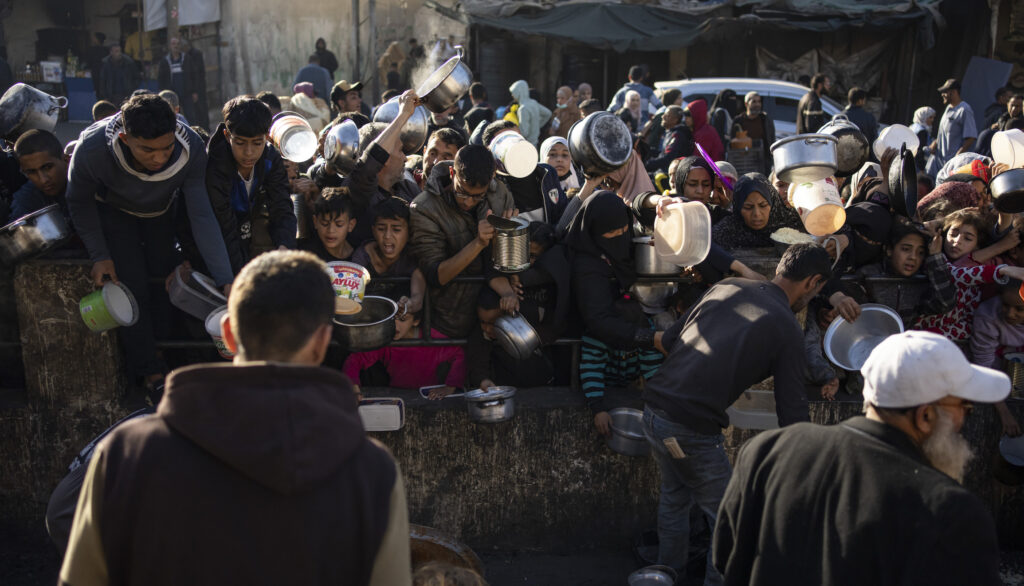The threat of famine in northern Gaza is “imminent” and will likely worsen in the coming months, according to a warning from global experts on food security.
“Famine is imminent in the northern governorates and projected to occur anytime between mid-March and May 2024,” said the Integrated Food Security Phase Classification global initiative report, which was released on Monday.
The warning comes as Israel prepares for additional military operations in the southern Gaza city of Rafah, where a significant portion of the population is currently seeking shelter. Israeli leaders have said they would carry out operations in Rafah to target the remaining Hamas fighters, though their plan for protecting the civilians that fled there remains a mystery.
From Feb. 15 through March 15, the IPC found that a plurality of Palestinians, roughly 876,000 people, fit into the Phase 4 “People in Emergency” category. There are five phases in the food insecurity scale. Six hundred and seventy-seven thousand Palestinians fell into the Phase 5 category, the most severe, which is reserved for “People in Catastrophe.” At that time, there were 578,000 in the “People in Crisis” group, or Phase 3, while there were 96,000 people in the “people stressed,” or Phase 2, category. No one placed in Phase 1, which denotes the group of people who have food security.
The projections from now through mid-July paint a worsening picture. They project that through mid-July, almost half of Gaza’s population would fit into the Phase 5 category, while just shy of 40% will fall into Phase 4, with the remaining percentage falling into the third phase.
The humanitarian situation is worse in the northern part of the strip, where roughly 300,000 people remain despite evacuation orders from the Israeli military earlier in the conflict. In addition to a lack of aid, there are also security concerns about how the aid can get to northern Gaza and be distributed to the local population.
The European Union’s foreign policy chief, Josep Borrell, accused Israel of starving Palestinians as a “weapon of war.”
“In Gaza we are no longer on the brink of famine; we are in a state of famine, affecting thousands of people,” Borrell said at the start of a conference on humanitarian aid for Gaza, according to the Washington Post. “This is unacceptable. Starvation is used as a weapon of war.”
The United States is one of many countries that are airdropping aid into Gaza, while other aid is arriving by sea, even though experts have said getting aid into Gaza is most efficient by land. Israel controls the land crossings from Israel into Gaza, and the U.S., among others, has urged Israel to open up additional crossing points to allow additional aid to get into Gaza. Last week, the Israelis allowed aid through a northern crossing for the first time.
U.N. Secretary-General Antonio Guterres said: “This is the highest number of people facing catastrophic hunger ever recorded by the Integrated Food Security Classification system — anywhere, anytime.”
There are also concerns about how additional Israeli operations into Rafah, the southern Gaza city where more than a million Palestinians have fled to under Israel’s advisement could affect the humanitarian situation there.
“From mid-March to mid-July, in the most likely scenario and under the assumption of an escalation of the conflict including a ground offensive in Rafah, half of the population of the Gaza Strip (1.11 million people) is expected to face catastrophic conditions (IPC Phase 5), the most severe level in the IPC Acute Food Insecurity scale,” the report said. “This represents an increase of 530,000 people (92 percent) compared to the previous analysis.”
The U.S. and European governments have urged Israel not to go into Rafah without significant effort to clear the civilian population out of harm’s way, while those leaders have also urged their Israeli counterparts to do more to prevent the growing concern about widespread famine.
Israeli Prime Minister Benjamin Netanyahu’s office said last week that he approved a military plan for Rafah, though it did not provide a timeline of when operations there would commence.

The rift between Netanyahu and the U.S. has been more stark in recent weeks. Biden said full-scale operations in Rafah without ample planning to avoid civilian casualties would be a red line for him, while Netanyahu hit back at that comment.
Netanyahu also took shots at U.S. Senate Majority Leader Chuck Schumer (D-NY), who called for new Israeli elections last week and said the Israeli prime minister “has been too willing to tolerate the civilian toll in Gaza, which is pushing support for Israel worldwide to historic lows.”
Biden and Netanyahu are reportedly expected to speak on Monday for the first time since Schumer’s remarks.
Israeli military operations continue in Gaza, including at the Shifa hospital in the northern part of the strip, which had been the site of earlier fighting.
CLICK HERE TO READ MORE FROM THE WASHINGTON EXAMINER
“IDF troops are currently conducting a precise operation in the area of Shifa hospital—based on intelligence information indicating the use of the hospital by senior Hamas terrorists to conduct and promote terrorist activity,” the Israel Defense Forces said on X.
A primary part of Hamas’s war tactics is to hide among civilian Palestinian populations, such as at hospitals, schools, mosques, and more, in order to force the Israeli forces to either incur civilian casualties or temper their actions to prevent them.

